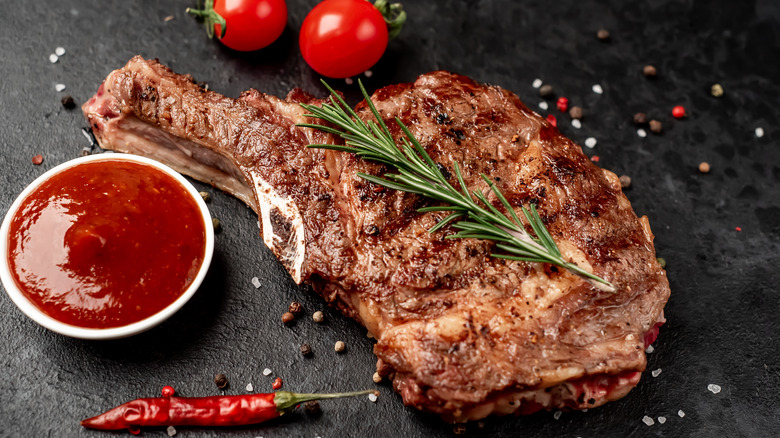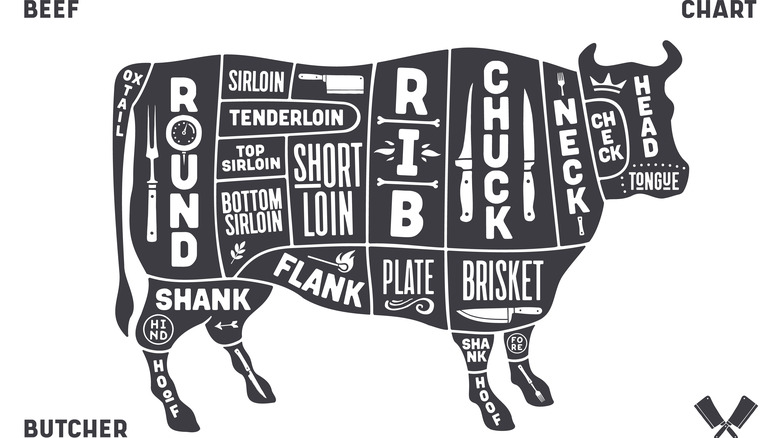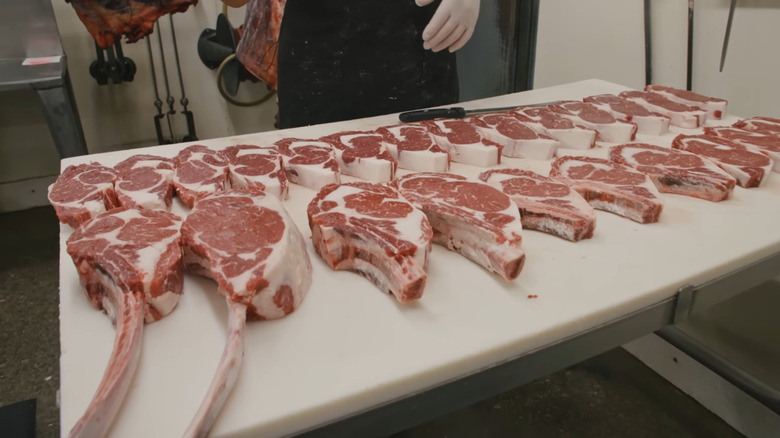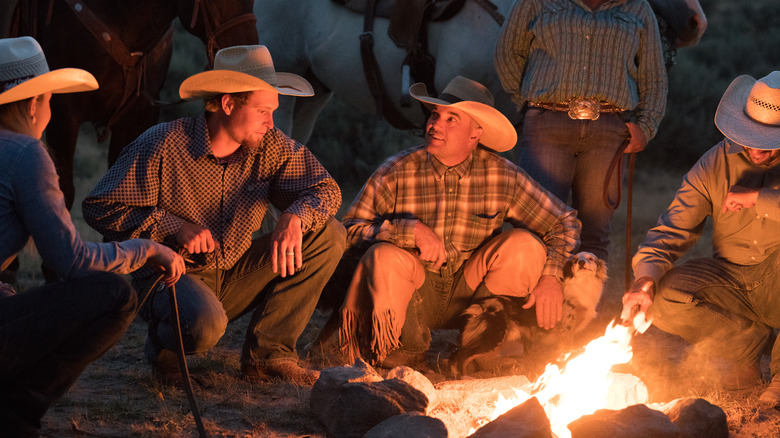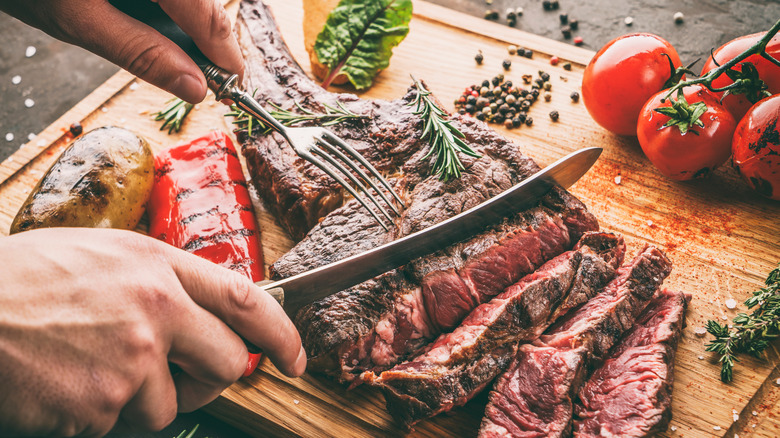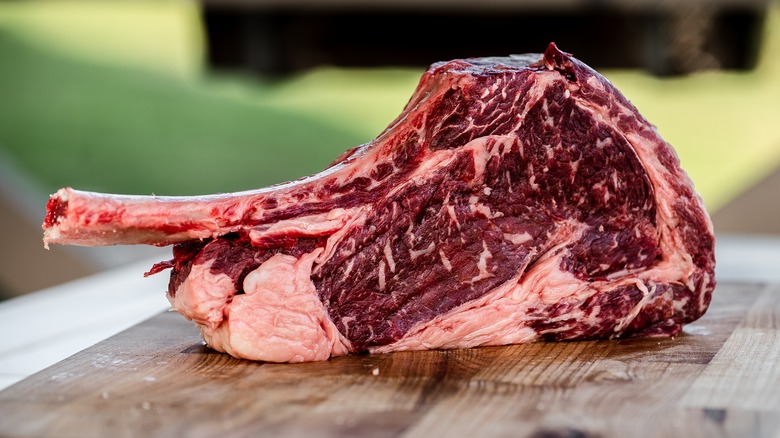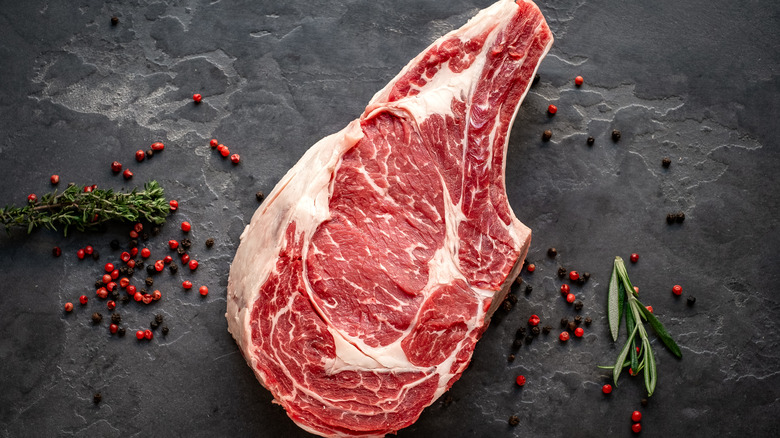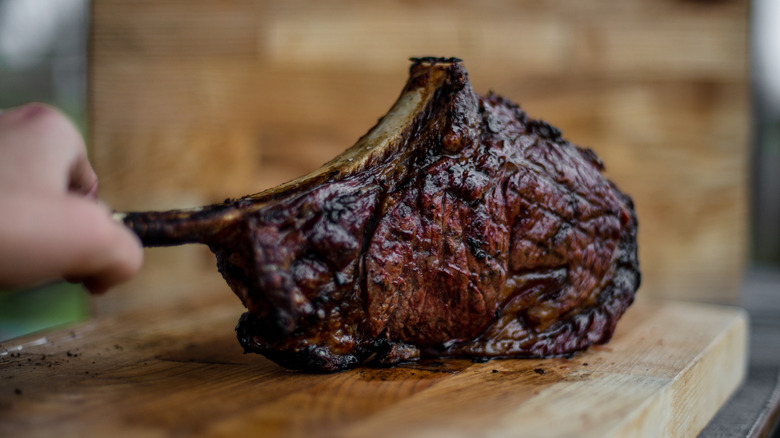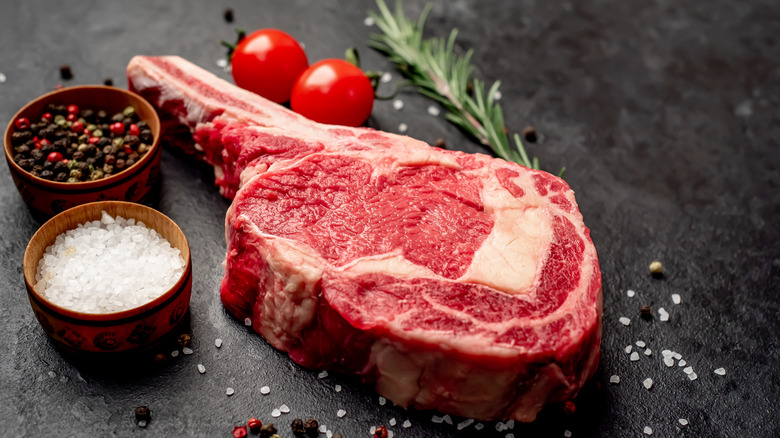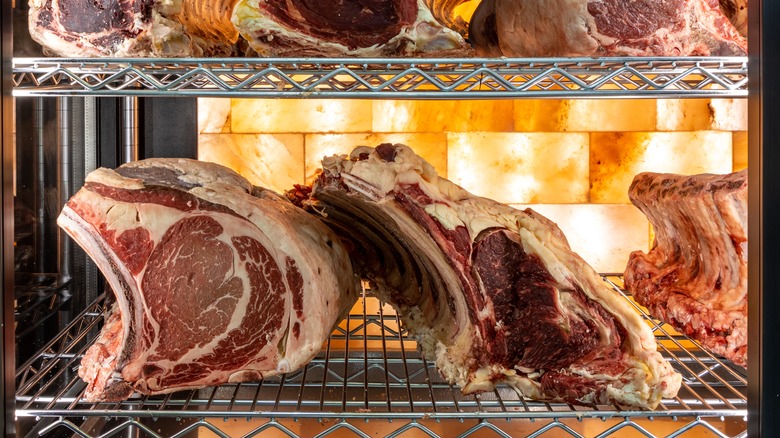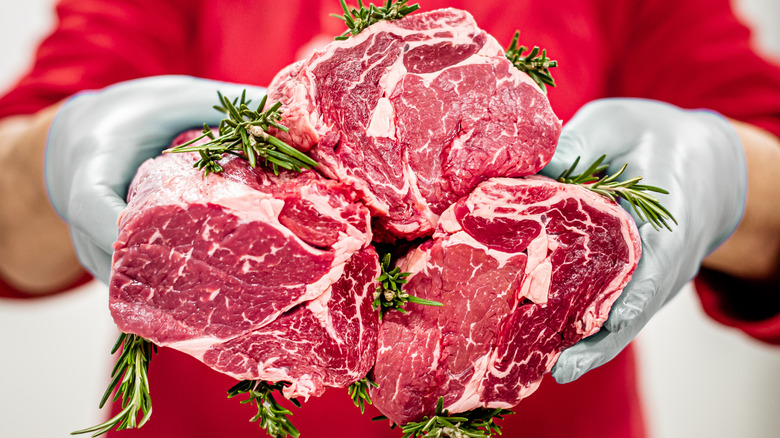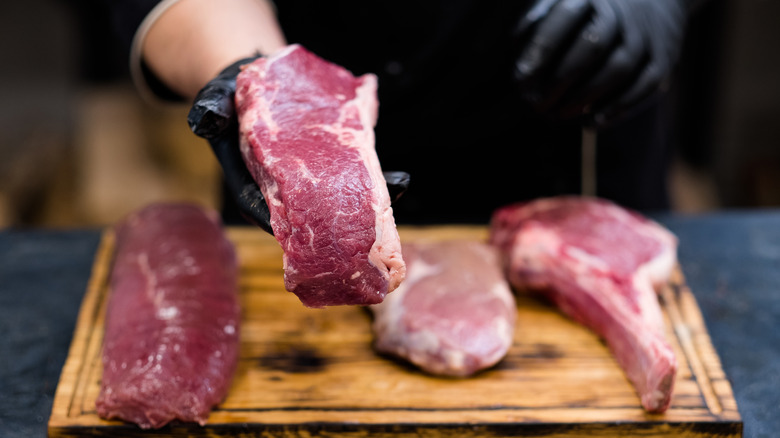Why Cowboy Steak Is One Of The Best Cuts You Can Buy, According To A Butcher
With beef production in America estimated at 26.96 billion pounds in 2023, according to global data company Statista, you could say that meat is a big part of the culture in the U.S. How this beef is consumed, though, varies wildly in quality and preparation. In our ranking of the best and worst cuts of steak, ribeyes came out on top. But there's an elusive subcategory of ribeye that may take the cake.
The cowboy steak is a special version of the ribeye that flies under most radars, and while this cut of meat may not be the most popular steak on the menu, it is one of the best cuts you can buy. Since common knowledge about this delectable cut of meat is slim, we consulted with two experts on the craft of butchery. Luis Mata and Gabriel Llaurado are co-founders of Meat N' Bone, an online butcher shop that delivers premium cuts of meat all over the U.S. Together, they've helped us understand why the cowboy steak is a cut above the rest.
What, exactly, is a cowboy steak?
You may have never heard of a cowboy steak before, but chances are that you've seen one. The lesser-known steak is also referred to as a frenched bone-in ribeye. You have likely encountered this alternative name on upscale menus and glass butcher cases in grocery stores and markets. A regular ribeye with the bone trimmed away and a tomahawk steak are sibling cuts of the cowboy steak and are more commonly used.
At its core, a cowboy steak is a bone-in ribeye and is sourced from the ribs of the cattle. As a ribeye, this steak features a healthy mix of tender red meat and ribbons of fat, or marbling. Its marbling is what makes the ribeye one of the most desirable cuts of meat, but the cowboy steak comes with the added bonus of being bone-in. The bone is thought to add flavor and moisture to the meat, making it a valuable addition for some steak lovers. The bone is trimmed to stretch a few inches below the steak meat.
Simply calling a cowboy steak a ribeye may be true and more descriptive, but it does sacrifice some of the cut's personality. The cowboy cut is a nod to beef's history in North America when cowboys would wrangle cattle throughout the West. Calling this particular ribeye a cowboy steak also ups the appeal for those meat-eaters who believe chowing down on a hunk of flavorful meat is a manly endeavor.
The difference between a cowboy steak, a ribeye, and a tomahawk steak
In the world of meaty steaks, where does the cowboy cut find itself? Meat N' Bone's co-founder Gabriel Llaurado explains that cowboy steaks, along with tomahawks, are basically extensions of the ribeye steak. "Tomahawks, Cowboys, and Ribeyes are essentially all ribeye steaks," Llaurado tells Mashed in an exclusive Q&A. He goes on to explain that the variations are slight, adding that they are "differentiated mainly by the presence and length of the bone."
Your run-of-the-mill ribeye has been trimmed of its rib bone. The tomahawk, on the other hand, is considered the king of ribeyes and has a bone that protrudes up to a foot from the bottom of the steak. If the tomahawk is king, then the cowboy steak is a prince, with its bone intact but trimmed shorter than its kingly counterpart.
This distinction means that all cowboy steaks and tomahawks are ribeyes, but not all ribeyes are cowboy steaks and tomahawks. As one of the most popular steaks you can buy, ribeyes are commonly found on restaurant menus and in stores. The cowboy cut and tomahawk varieties, however, are considered a bit more prestigious and out of reach for the average diner or shopper. Besides price, availability, and the obvious bone divergence, all three variations of steak are virtually the same.
The cowboy cut's name is an ode to American history
Beef has played an important role in history around the world, as cattle have been a major source of food in many regions. When it comes to American history, beef helped with the country's expansion out West, where cowboys would drive cattle along trails to rail stations and population centers. Cowboys on the trail had a simple and sturdy diet, consisting largely of foods they could find in nature. Naturally, the cows they were herding became a source of sustenance as well.
The exact origin of the term cowboy steak is murky, but many consider its name a product of these wranglers' diets. Ribeyes were seemingly the perfect meal for someone performing physical labor all day on horseback. The combination of protein and fat would provide cowboys with substantial fuel for their labor-intensive work. This source of rich protein was especially important because cattle were plentiful and other calorie-heavy foods on the cattle trail could be scarce.
The cowboy steak's defining feature is, of course, its protruding bone, which also has its place in history. There are claims that the cowboy cut's name comes from this little handle of a bone, as cowboys allegedly used it to easily hold their supper over a campfire. This method of cooking can be replicated today, putting steak lovers and history buffs into the boots of long-gone cowboys.
Cowboy steak is a flavorful cut
There's a reason ribeyes are one of the most preferred steaks, and that's because they just taste so good. They're the optimal blend of juicy steak and buttery fat. According to Gabriel Llaurado of Meat N' Bone, the cowboy steak may be the ideal steak for many meat eaters in terms of flavor. "The cowboy steak is perfect for anyone who loves their meat juicy, tender, and well-marbled, which all translates to superb flavor," he states.
Unlike cuts of meat like the filet, which is famous for not containing much fat at all, cowboy steak brings a complex mix of flavor to the table. Once cooked, a cowboy steak's ribbons of fat will melt and infuse into the meat, creating that rich, signature ribeye taste. Each mouthful of a cowboy steak will be bursting with that self-moistening flavor, which is one reason fat is so important on a steak. This is also why people tend to say ribeyes will melt in your mouth.
Bone-in is better
This is where we talk about the myth of the meat. The bone of a steak or ribeye is revered by some steak experts, who claim that cooking the bone at high heat will release the marrow, adding a rich flavor to the steak. This actually isn't true because even through the cooking process, there is no way for the marrow to escape the bone and infuse the meat. So, why are there chefs from all over the world who swear by a good bone-in steak?
Though this marrow theory is a common myth about steaks, Meat N' Bone co-founder Gabriel Llaurado tells us the bone does indeed matter. According to him, it is "enhancing the flavor and moisture content during cooking, as the bone conducts heat within the meat." As a conductor, the bone takes heat into itself, which makes the surrounding meat take a little longer to cook. This keeps the meat closest to the bone moist, tender, and utterly delicious. It may not be the marrow adding flavor to your bone-in steak, but that hunk of bone isn't totally for show either.
The marbling on a cowboy steak is top notch
Ribeyes, and cowboy steaks by association, are known for their superior marbling. A cowboy steak may have a leg up in the fat department, though, thanks to its bone. Leaving the bone intact in a ribeye may not increase marbling, but it does accentuate it. The temperature control feature of the bone helps to bring out that buttery flavor of the fat.
All steaks can come in a variety of grades, and each will have an effect on the steak's marbling. Wagyu and Angus beef steaks have quite a bit more marbling, as the cows they are sourced from are fed diets high in grains like corn. The breeding and genetics of the cows are also important factors when it comes to increased marbling.
That being said, more is not always better when it comes to marbling — a fact that is highly dependent on personal taste. Meat expert Gabriel Llaurado recommends that steak lovers downgrade if they enjoy a higher ratio of red meat in their cowboy steaks, saying, "If you're looking for something a bit less fatty, steer clear of Wagyu cuts and choose a USDA Prime G1 Certified Cowboy steak instead." Don't worry, though, because all ribeyes will give you at least a few mouthfuls of marbling.
Ordering a cowboy steak makes an impression
If you had never heard of a cowboy steak before stumbling upon this article, you aren't alone. Because this ribeye variation is a lesser-known steak, ordering one in a steakhouse will impress. You'll sound knowledgeable of cuisine, and those in your company will consider you a real steak connoisseur, earning you at least a couple cool points.
While a good steak does more than put on a show, a big part of ordering a nice steak dinner is about presentation and first impressions. The cowboy cut certainly does this with its bone handle not only adding flavor but also some serious flare. "The bone not only enhances the visual appeal, making it more attractive and offering chefs creative plating options," Meat N' Bone's Gabriel Llaurado explains, "but it also adds a certain 'sexiness' to the dish that can elevate a dining experience." This means you will not have one, but potentially three moments of positive impression: the first when you place your order at a restaurant, another when it comes out plated beautifully, and a third if you're generous enough to share a bite.
Cooking a cowboy steak is convenient
Cooking a steak can be as simple or as complicated as you want to make it, with results typically ending up on a sliding scale of quality. When you're cooking a ribeye, though, even the simplest of cooking methods can result in a flavorful meal. The marbling of the steak will infuse flavor as it cooks, and the bone of a cowboy cut ribeye acts as a temperature control to keep moisture in. This means that simply slapping a cowboy steak on the grill can earn you a tasty dinner, and you can even use the bone-in handle as a means to flip the steak as it cooks.
When we asked Meat N' Bone experts Luis Mata and Gabriel Llaurado how to prepare a cowboy steak, they explained that there is more than one way to cook the tasty cut. "Prepare it just like a ribeye," Llaurado states. "That said, preparing a cowboy steak often involves different methods like reverse searing to manage its thicker cut and bone-in structure, ensuring even cooking and a flavorful crust." Even with these more complex methods in existence, they told us a perk of the cowboy steak is that it fits on most cast-iron pans. For the steak-loving traditionalist, there may be no better way to cook a cut of meat than with the flavor-infusing cast-iron skillet — and you can't easily do that in most pans with a tomahawk steak!
A cowboy steak can be paired with a range of flavors
When crafting a meal, it's ideal to pair complementing flavors to create a cohesive dish. Every cut of meat, even if from the same animal, tastes and feels a bit different from one another. The ribeye is a savory cut with marbling, and as such, it can be paired with many different bold flavors and combinations of tastes.
When asked about the taste of the cowboy cut, Gabriel Llaurado of Meat N' Bone had some suggestions about pairing the steak for optimal flavor. "Flavor-wise, its robust taste pairs well with bold seasonings and smoky BBQ flavors, and it also complements richer sides such as creamed spinach or a blue cheese sauce to balance its intense beefiness," he said. As a foundation, a cowboy steak holds up to other strong flavors, making it ideal for adding a crumble, sauce, or other aromatic toppings.
In addition to barbecue flavors and creamy sides, the buttery flavor of a fatty ribeye pairs well with powerful fruits, both bitter and sweet. They may not be the first thing you think of pairing with a hulking steak, but the defined flavors of pomegranate and cranberry can make a beefy meal pop. Sweeter fruits like apricots and peaches have a different effect on beef, making a ribeye taste lighter and more refreshing.
Cowboy steaks are prime for dry aging
You've likely heard of aged wine or cheese, but beef can also be aged. In fact, it usually is. Aging enhances flavor. Dry-aging beef can also extend its shelf life. The dry-aging process involves keeping large cuts of meat at a cool and controlled temperature and environment, typically anywhere from a few weeks to a few months. The longer a cut is dry-aged, the more umami flavor is brought out of the meat.
According to Meat N' Bone experts Luis Mata and Gabriel Llaurado, cowboy steaks in particular are great for dry aging. This is how Llaurado puts it: "One standout feature of cowboy steaks is that they are excellent for dry aging, which can really enhance their flavor and make them a fantastic choice for any meat lover." Their size, coming from the large ribeye roll, and marbling content are what makes them so prime for dry aging. Smaller cuts of meat dry out much too quickly for effective dry aging, and the fat in a steak is necessary for the desired flavor and moistness.
The cowboy cut gives you more bang for your buck
Ribeyes can certainly be a pricey cut of meat, with costs ranging wildly from around $15 per pound to $70 per pound depending on the source. You're paying for a prime section of beef. Within the ribeye family, though, the cowboy steak is going to make your money go further.
While the tomahawk steak is incredibly pricey, the cowboy steak by comparison is going to give you the same satisfaction at a lower price. According to Gabriel Llaurado and Luis Mata of Meat N' Bone, the tomahawk's defining feature is responsible for a higher price tag. "The tomahawk, often referred to as the king of steaks due to its impressive long bone and substantial size, tends to be pricier partly because you're paying for the weight of the bone and the special butchering required," Llaurado said.
The presentation of the magnificent tomahawk may be worth the price for some, but spending extra doesn't fill your belly any more. Llaurado and Mata call the tomahawk less economical, with Llaurado stating, "The bone's weight contributes significantly to the overall cost without adding to the edible portion." This means you're essentially paying for pretty. The cowboy steak is a bone-in ribeye that trims away this excess weight, giving you a more affordable, yet equally delectable steak. For example, Ruth's Chris Steak House shows a tomahawk is $154 for 40 ounces, a 22-ounce cowboy ribeye costs $80, and a plain 16-ounce ribeye is $68.
It's relatively simple to cut your own cowboy steaks
Ordering a cowboy steak at a restaurant can come with a hefty price tag, so can one purchased directly from the grocery store. If you're a steak lover, it'd be worth your while to make a trip to the butcher or a bulk grocery store like Costco to buy a ribeye roll. A ribeye roll is a large chunk of meat from the cow's primal rib area that ribeyes and prime ribs are cut from. Once you procure the slab of meat, you're able to easily trim away excess fat and use the ribs as a guide to slice the roll into individual steaks.
Once you've sliced your individual steaks, there isn't much work to be done. Essentially, all you need to do is trim the chunk of fat around the bone. Cut away the small square of fat, then scrape the remainder off the bone, and you're left with your cowboy-cut ribeye.
A primal rib roll contains seven ribs, so you'll be getting seven thick cowboy steaks for your efforts. Any steaks you don't cook right away can be easily vacuum-sealed and frozen until your next steak night. You'll likely want to enjoy the fruits of your labor well within the three years that a vacuum-sealed steak will last in the freezer. However, remember to write the date on your steaks so you know just how long that lost cowboy has been hiding.
